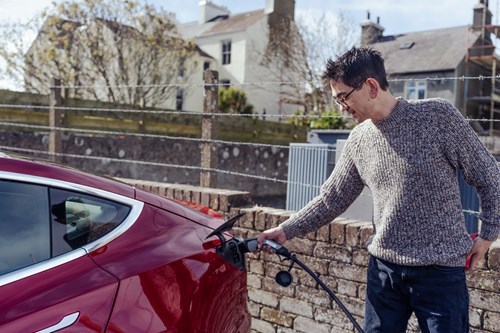Electric vehicles (EVs) are becoming increasingly popular as a greener alternative to petrol and diesel cars, reducing our dependence on fossil fuels and lowering greenhouse gas emissions from transport. However, like any emerging technology, EVs have been subject to their fair share of misconceptions. So, here are the facts about EVs, showing why they play an important part in our net zero transition.
EVs cut emissions by two thirds
One of the most persistent myths is that EVs are just as harmful to the environment as traditional internal combustion engine (ICE) cars. While it's true that the manufacturing of EVs and their batteries has a carbon footprint, their operational phase is significantly cleaner. EVs produce zero tailpipe emissions and reduce lifecycle greenhouse gas emissions by approximately two thirds compared to an equivalent petrol car in UK conditions.
In general, EVs cut carbon emissions significantly, even if they mainly run on coal- or gas-fired electricity. They also reduce air pollution emissions significantly, although some particulate pollution from the tyres remains and is an important focus of current research and proposed new emissions standards. In the Isle of Man, where electricity production is still reliant on fossil fuels, the emissions benefits of EVs are currently smaller, but they will increase as we decarbonise our energy sector.
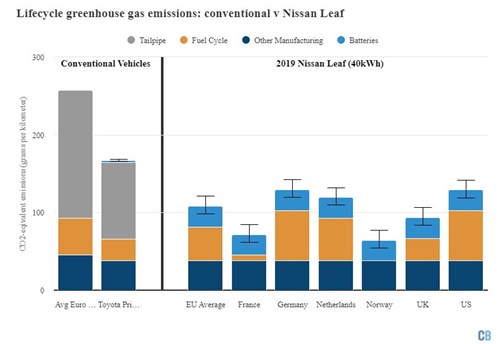
Photo credit: Carbon Brief
EVs are increasingly being powered by renewable electricity
Sceptics often claim that EVs are powered by electricity from burning coal or other fossil fuels, which negates their climate benefits. Indeed, the carbon intensity of the grid (the greenhouse gas emissions per kilowatt hour of electricity) is an important factor in how clean an EV’s operation is, but this is constantly improving as more renewable energy sources like wind and solar are integrated. Therefore, as renewable energy generation becomes more prevalent, both in the UK and with the Island’s target for carbon neutral electricity by 2030, the carbon footprint of EVs will continue to decrease, making them a key part of a sustainable transportation future.
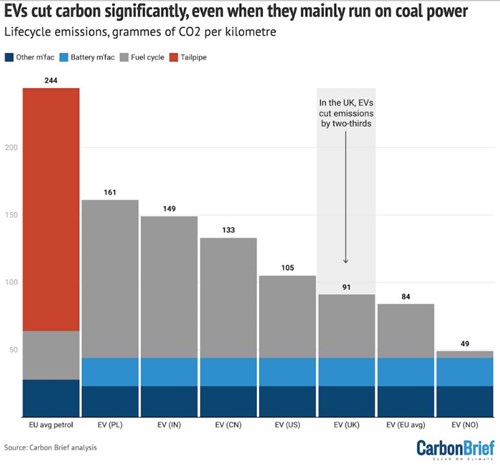
Photo credit: Carbon Brief
EV manufacturing is making sustainable strides
Concerns over the production of EV batteries can put some people off switching to EVs. It is true that manufacturing lithium-ion batteries involves extracting materials like lithium and cobalt, which can be environmentally damaging. There can also be challenges in ensuring the transparency and sustainability of sourcing these materials; an issue that’s relevant to a range of manufactured goods, including smartphones and laptops. Ensuring responsible and ethical supply chains is a focus of international efforts, and battery technology is also evolving. Many EV manufacturers are investing in battery recycling programmes and alternative battery chemistry. A company who has developed a cleaner, safer and more cost-effective way to produce EV batteries was one of the winners at this year’s Earthshot Prize awards. And a new recycling method developed by the Chalmers University of Technology in Sweden allows 98% of lithium to be recycled.
EVs cost less overtime and the second-hand market is growing, making them more affordable
While some high-end EV models come with a premium price tag, there are more affordable options. There can be a higher upfront cost compared to an ICE vehicle, but this overlooks the lower operational costs of EVs, including lower charging costs and reduced maintenance expenses, which makes them cheaper on a total cost of ownership basis. Investment in EV technology and the UK government’s EV sales targets for manufacturers, means that the availability of affordable models is increasing, reducing the price gap. This will drop further as the supply of second-hand EVs increases, making green transport more accessible to all. Buying second-hand is also more sustainable than buying new.
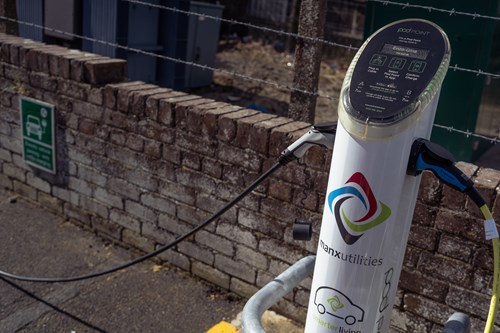
EVs charging infrastructure is continually expanding
Our public charging network is expanding, overseen by Manx Utilities and their rollout of Pod-Point charging stations, with a map and user guide available online. Additionally, fast chargers are being installed across the Island, providing a rapid charge when needed, and some people can set up home charging, with reduced electricity tariffs for charging overnight. Modern EVs also offer impressive ranges, often exceeding 200 miles per charge, so range anxiety is less of an issue on the Isle of Man.
EV fires are five times less likely than their petrol/DIESEL equivalent
Misinformation about the fire risks of EVs is rife – but what does the evidence tell us? Analysis shows that EV fires are less common than petrol and diesel fires, and thermal runaway fires (an overheating event which triggers chemical reactions in the battery) are rare – they are about five times less likely than other accidental car fires. Vehicle manufacturers have progressed EV technology to mitigate fire risks, with battery management systems in place to monitor faults and flag any issues. The perception that EVs are going on fire more often than ICE cars may also stem from more frequent reporting of accident-related fires in EVs, which are viewed as more newsworthy. However, in the event of an EV fire, firefighters are equipped with the necessary operational guidance and knowledge to deal with such an event, just as in the case of an ICE vehicle fire.
Alternatives to EVs like hydrogen and synthetic fuels are not yet available or affordable
Some people suggest we should be focusing on other forms of green transport, powered by hydrogen or synthetic fuels. While many expect hydrogen to play a role in decarbonising transport, this looks most applicable to heavy-duty vehicles and shipping, rather than cars and vans. At present, only 4% of global hydrogen production is by low-carbon methods, and it has lower efficiency across the energy chain (from primary resources to end-use), so it is still some way off becoming a useful complement to electrification. There is also growing hype around synthetic fuels, however it seems unlikely they will be widely available or affordable for everyday use. To avoid creating unsustainable demand, they may also be best suited to only those modes with no alternatives (such as long-haul aviation). For cars and vans, EV technology is the chosen route for most manufacturers, and allows us to make carbon savings right now.
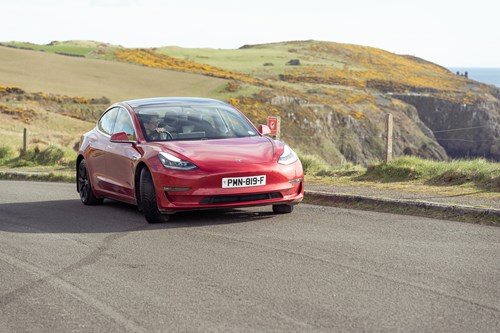
Why you should consider an EV if you are replacing your car
It can seem easier and more comfortable to stick with the status quo, but the use of fossil-fuelled vehicles is causing continued and widespread environmental and social damage, much of which is far-removed from our own experiences of purchase and use. Fossil fuel extraction and transportation damages water, land and ecosystems, generating pollution and waste which are harmful to public health, and drives global climate change. Its societal impacts range from the effects on communities in areas where fossil fuels are extracted, to those who are suffering the worst of the impacts of climate change – often in countries which have contributed least to this problem. However, no-one is expecting people to get rid of perfectly good cars, which is a myth in itself!
While some may view EVs as niche products, suitable only for a small group of environmental enthusiasts, major automakers are investing heavily in EV technology and launching an increasing number of electric models. While there are still some challenges associated with EV adoption, such as improving battery sustainability and expanding charging networks, the environmental and practical benefits of EVs are clear. As technology continues to advance, EVs are positioned to play a pivotal role in reducing greenhouse gas emissions and transforming the automotive industry for the better.

